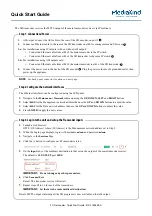
Rx battery power supply.
Such a battery pack is typically composed of 4 or 5 NiMH cells assembled in series. It supplies a voltage of between 5 and
6 V in operation.
The capacity of this battery should be chosen depending on the number and type of servos involved in the model. The
higher the number, the greater the consumption of servos is important, and the battery capacity must be high.
For example, an airplane pilot learning (Trainer) with 4 standard analog servos will be equipped with four NiMH battery
800 to 1500 mA.
A sports model with 6 or 7 servos is preferably equipped with a battery of at least 1500 mA.
BEC regulator system
The BEC is an electronic accessory, which can be directly integrated into a controller for an electric motor or otherwise
used independently. In both cases, the regulator will deliver a voltage between 4.8 V and 6 V (typically 5 V or 5.5 V). It will
also support the total current consumed by the receiver and servos. He will finally be able to dissipate heat more or less
that will emerge during use.
Remember that a linear BEC heats generally more and that its use is limited to a 2 or 3S LiPo battery pack (up to
4 servos).
On the contrary, a switching BEC, often called SBEC or UBEC can often support a higher battery supply voltage.
In all cases, strictly observe the limitations stated in the instructions of the device. Risk of crash.
To function properly, the receiver must have a power supply always greater than 3.3 V, regardless of the circumstances
and the use of servos. If the power supply drops below the operating threshold of 3.3 V, even very briefly, the receiver
will reboot automatically. The result is an immediate loss of connection with the issuer, and disastrous consequences for
the model and the security of persons and property.
If such a situation occurs, the receiver requires a little less than a second to restore the connection after the power
supply has returned to its nominal value. It is therefore essential to ensure that this situation can not occur at no
circumstances onboard of your model.
Similarly, you must ensure that the power wires have a sufficient cross section to support the total current consumption.
Finally, you should make sure the switch is in perfect working condition.
We advise you to use whenever possible a safer electronic switch type, or you simply pass switch.
4.6 BIND SECURITY (FAILSAFE)
The receiver of your radio control system is equipped with a safety feature that intervenes in the case of temporary or
prolonged loss of connection. It sets each servo in a position you can define this way :
1/ Transmitter on, press and hold the button on the receiver and turn on the power. The red LED lights for 1 sec and then
turns off after 1 s.
2/ Immediately release the pushbutton. The red LED will emit 3 flashes very fast and stay on.
3/ Position and hold the sticks and switches on the transmitter in the position you need (the one you want the servos to
take in case of loss of connection, eg gas at idle).
4/ Press the push-button of the receiver. The Red LED flashes 3 times again very fast and stays on to indicate that the
positions are stored in the receiver.
5/ Turn off the transmitter and receiver.
6/ Turn on the transmitter and the receiver and verify that you normally control the servo.
7/ Turn off the transmitter. Check that the servos immediately go to their safety position programmed in steps 3 and 4.
Repeat the process in case of failure.
2 CARACTERISTIQUES
4 OVERALL FEATURES
31
!
i
i
Содержание PTR-6A
Страница 1: ...MODE D EMPLOI RADIOCOMMANDE PTR 6A V 1 0 ...
Страница 22: ...22 ...
Страница 23: ...USER MANUAL PTR 6A Transmitter V 1 0 ...
Страница 44: ...44 ...














































